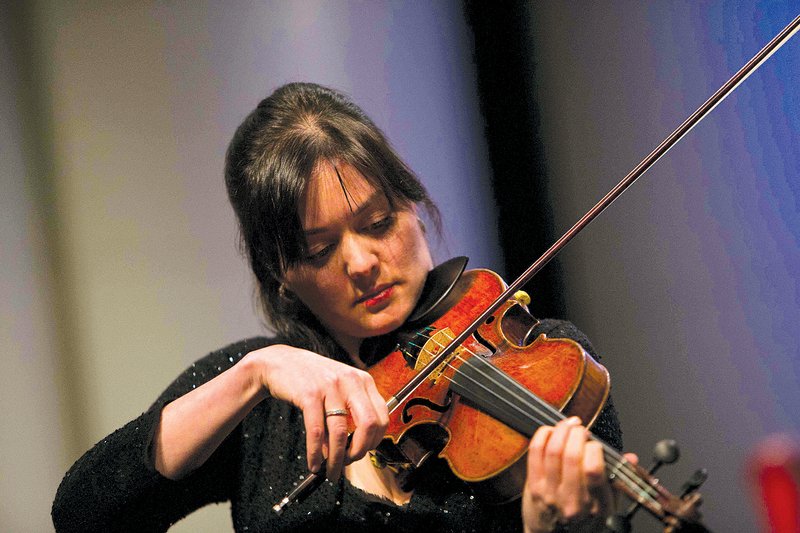The concert is titled "Fairytales," and Paul Haas, music director of the Symphony of Northwest Arkansas, promises the first performance of 2015 will live up to its name.
"Music tells a story, and SoNA's 'Fairytales' is devoted to pieces that accomplish that storytelling in a dramatic and compelling way," Haas says.
FAQ
SoNA:
Masterworks II
WHEN — 7:30 p.m. Saturday; ticketholders are also invited to attend a pre-show Creative Conversation with Maestro Paul Haas at 6:30 p.m.
WHERE — Walton Arts Center in Fayetteville
COST — $28-$50
INFO — 443-5600
"After the intermission, audiences will hear a heart-wrenchingly beautiful declaration of love from Khachaturian's ballet 'Spartacus,' followed by a suite from the orchestral tour-de-force 'The Firebird.' With a kaleidoscope of instrumental colors and breathtaking virtuosity, SoNA musicians will bring these tales to life in stunning definition," he describes.
But first comes Rimsky-Korsakov's "Scheherazade," "the stories from Arabian Nights we all know and love," he says, with "ravishing solos by our concertmaster Winona Fifield."
Fifield, who lives in England with her husband, conductor Nathan Fifield, agreed to answer five questions for What's Up!
Q. Can you explain what a concertmaster does? And is the concertmaster always a violinist?
A. That is a big question! The role of the concertmaster is manifold. First of all, the concertmaster, being the first chair in the first violin section, is the leader of that section. As leader, he/she will set the example of how the rest of the players should play their part -- how much bow to use, what kind of articulation to use, starting and stopping together, moving together as a group. The goal is for the section, comprised of many people, to sound like one person playing. When questions arise concerning the music, how it should be played, etc., it is the concertmaster who makes the ultimate decision. The concertmaster has an additional leadership role over the entire string section -- the second violins, violas, cellos and basses, by communicating with the principals of each of those sections. I love the kind of nonverbal communication that occurs between myself and the other string principals as we play music together. We seek to coordinate our playing as if we were in a small string quintet. That information then gets passed back to the section players, thus amplifying our original intentions. It is a thrilling experience to play in an orchestra that is of one mind. Lastly, the concertmaster acts as a musical (and at times nonmusical) liaison between the musicians and the conductor. A conductor can make any kind of motion with the baton, but that movement must be interpreted, and that is what the concertmaster does. If the conductor makes a big gesture for the orchestra to come in, they actually won't move a muscle unless the concertmaster does. It's quite amazing.
The concertmaster is always a violinist. The reason has to do with the history and development of the orchestra dating back to the 17th century.
Q. How did the violin become your instrument of choice?
A. Funny enough, I did not choose the violin nor do I have any memory of starting. I was 3 years old, and my mother made the decision that I would play the violin. I guess I was OK at it and enjoyed it enough to stick with it all these years!
Q. It seems as though the violin speaks very deeply to many listeners. Do you agree? And if so, why do you think that's true?
A. Yes, I think so, too. The violin is the most remarkable instrument -- in my unbiased opinion! My personal opinion is that the sound of string instruments most closely mimics the human voice. String instruments can be extremely expressive: They have a much larger range of sounds than wind instruments. This kind of flexibility and dynamic range resonates in a very special way within us. It is a sound we recognize unconsciously as our own.
Q. Tell us about the piece you're playing.
A. This piece tells the story of a beautiful maiden, Scheherazade, who every night tells a captivating story to the Sultan so that he won't behead her. After 1,001 nights of storytelling, the Sultan has fallen in love with her and spares her life.
Q. What do you hope your solos convey to listeners?
A. This is one of the most famous concertmaster solos in the repertoire. The solo violin represents Scheherazade. Each movement is the telling of a new story and begins with the violin playing the same theme, or a variation of it. It's like Scheherazade begins each story with the same refrain, "Once upon a time ..." I hope that I can tell the story with my playing, that the music will draw the listener into the exotic and sensuous world of the Arabian Nights.
-- Becca Martin-Brown
NAN What's Up on 01/30/2015

